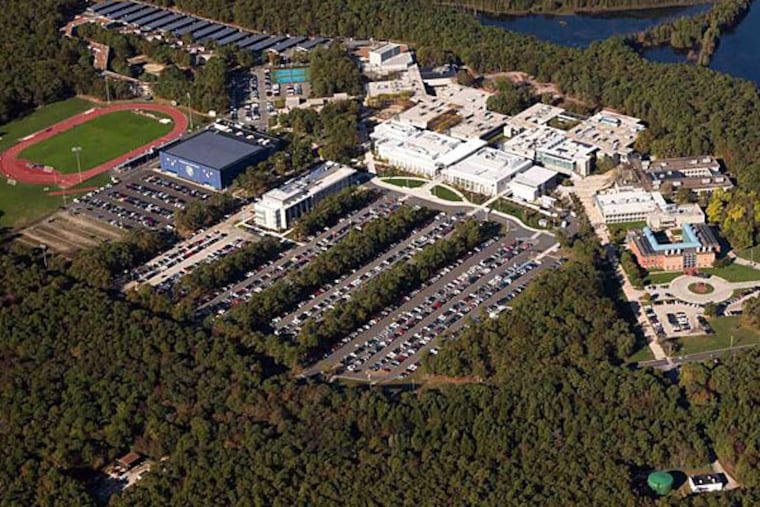Stockton aims to save its surrounding forest
GALLOWAY TOWNSHIP, N.J. - George Zimmermann calls it a "living classroom." Leaving PowerPoint presentations and books behind at Stockton University, the professor leads his students into the Pine Barrens that surround the Atlantic County school like a vast emerald ocean.

GALLOWAY TOWNSHIP, N.J. - George Zimmermann calls it a "living classroom."
Leaving PowerPoint presentations and books behind at Stockton University, the professor leads his students into the Pine Barrens that surround the Atlantic County school like a vast emerald ocean.
They walk among shortleaf pines, white oaks, red maples, and Atlantic white cedars while taking up tough questions: How can they manage the forest's health? How can they protect it from fires, pathogens, and insects?
For the first time, students will try to answer these questions during regular field visits as Stockton's 1,500-acre forest becomes a sprawling laboratory.
Within weeks, the university will begin executing the state's first comprehensive stewardship plan on public land in the Pinelands.
The New Jersey Forest Fire Service is expected to start prescribed burns to eliminate underbrush and lessen the likelihood of wildfires, and loggers will thin trees to open up the canopy and create healthier conditions.
"This is a forest with a college in it - not a college with a forest attached to it," said Zimmermann, a forest ecologist and professor of environmental studies. "The emotional experience that humans have while at this learning institution can be directly linked" to the forest setting.
Less than a football field's length from their classrooms, students "get to see things with their eyes," Zimmermann said. "It's different from a slide show or a movie.
"When they're walking through an actual experiment, their reactions and questions are much better," he said. "There's only so much you can show them in the classroom."
Some one- to two-acre patches of forest will not be managed through tree-thinning in order to provide a contrast for students studying the impact of stewardship practices.
"You have to show that contrast," said Zimmermann, who teaches ecological forest management, dendrology, and other courses. "We want to demonstrate to the public what's going on."
The stewardship plan was developed by Bob Williams, owner of Pine Creek Forestry L.L.C. in Laurel Springs, Camden County, a certified forester with 40 years of experience.
The university hired him as a consultant, and the New Jersey Pinelands Commission approved his 10-year plan.
"Rather than sitting in a classroom, we're able to go out in a real forest, touch a tree, and explain why this one is being saved and another is being cut," said Williams, who joined Zimmermann and Catherine Tredick, an assistant professor of environmental studies, during a field trip in February.
Williams wrapped pink ribbon around shortleaf pines, which will be saved during the thinning. Over the last 30 years, the species has undergone a drastic decline.
"We're making sure no one even thinks of cutting one," he said. "There's nothing like taking students through the forest instead of reading a book about it.
By going into the Pinelands, "what you learn from the books means so much more," Williams said. "The students don't have an idea of what a forester and biologist does, and this way they find out more about the professions that are out there."
Stockton has begun taking aggressive steps to manage the forest because of the threat of fires and the Southern pine beetle. In the last several years, the beetle has devastated huge swaths of the Pinelands, including 14,000 acres in 2010 alone, according to the state Department of Environmental Protection.
Evidence of the insects' devastation is apparent across the street from the campus at the Swan Lake resort on East Moss Mill Road, where 3,000 trees have been wiped out. The resort has scores of modular houses.
"If you drive in, it looks like Armageddon," said Swan Lake owner Paul St. James, who had 2,000 trees removed and is looking forward to restoring the forest. "I feel bad for Stockton; it will be cannon fodder" for the beetles.
"I hope it doesn't face what we faced but I don't see how it will escape," he said. "The properties are connected."
That's where Williams and Zimmermann and the Stockton Forest Plan come in. The management and study of the university's forest are expected to help head off the threats against it.
The first phase of the work will begin near the Swan Lake Resort to create a buffer that reduces the risk of beetle infestation and fires.
The thinning will remove the weakest trees and open the crown of the forest, dispersing the beetle pheromones that attract more insects. Along with controlled burns, it will also help reduce the possibility of wildfires.
Students will watch the strategies unfold on campus over the coming months.
"The forest gives Stockton a wonderful feeling," said Williams. "The trees give it an aesthetic quality, different from the experience of a college in the city. "It really is a forest with a college in it," he said.